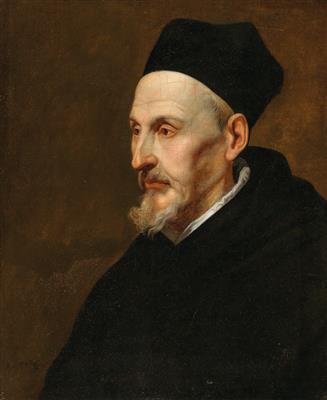Pieter Thijs
[Saleroom Notice]
(Antwerp 1616–1677)
Portrait of Antonius Triest (1576–1657), Bishop of Ghent and Bruges,
bears signature and date lower left: Peer Thijs Fecit 1650,
oil on canvas, 55 x 44.5 cm, framed
The signature and date appear to have been added at a later date.
Provenance:
Private collection, Belgium
The present portrayal of Bishop Antonius Triest by Pieter Thijs is a striking depiction of an important patron of the Flemish Baroque, who commissioned earlier works not only from Thijs’s own master, Anthony van Dyck (1599–1641), but also a major altarpiece from van Dyck’s own teacher, Peter Paul Rubens (1577–1640) , entitled the Conversion of Sint Bavo, circa 1623–1624, which still hangs in the Saint Bavo’s Cathedral in Ghent.
The present portrait is one of the last of this important Flemish Clergyman, earlier portrayals by David Teniers the Younger (1610–1690) and another by van Dyck are conserved in the Hermitage, St. Petersburg, (inv. no. ГЭ 589) and the Museum of Fine Arts, Houston (inv. no. BF. 1977.2) respectively. Triest’s monumental and refined funerary monument, also in Saint Bavo’s Cathedral, was likely commissioned around the same time as the present portrait, from Jerome Duquesnoy II (1602–1654) of the celebrated dynasty of sculptors whose most famous work is the Manneken Pis fountain in Brussels. Beyond his role as commissioner of such accomplished artworks, Triest remains an important historical figure for his courage in tempering the Counter-Reformation, as a protector of the adherents of the Jansenist heresy, in which he was both opposed by the powerful Jesuit order in Antwerp and even censured by Pope Innocent X.
The current canvas exhibits Thijs’s technical skill and ability to evoke the presence of the sitter, honed first in van Dyck’s workshop and then developed as an independent master. Admitted to the Guild of Saint Luke in Antwerp in 1644, where he served as treasurer, councillor, and coordinator of charities, he also worked for Archduke Leopold William of Austria, Governor of the Spanish Netherlands and for the Dutch court in The Hague. Seventy years after Thijs’s death, the art historian Jean-Baptiste Desamps lauded Thijs’s oeuvre for possessing ‘a lot of spirit, vibrant colours, and a lively manner’.
Esperto: Damian Brenninkmeyer
 Damian Brenninkmeyer
Damian Brenninkmeyer
+43 1 515 60 403
oldmasters@dorotheum.com
09.06.2021 - 16:15
- Prezzo realizzato: **
-
EUR 35.300,-
- Stima:
-
EUR 12.000,- a EUR 18.000,-
Pieter Thijs
[Saleroom Notice](Antwerp 1616–1677)
Portrait of Antonius Triest (1576–1657), Bishop of Ghent and Bruges,
bears signature and date lower left: Peer Thijs Fecit 1650,
oil on canvas, 55 x 44.5 cm, framed
The signature and date appear to have been added at a later date.
Provenance:
Private collection, Belgium
The present portrayal of Bishop Antonius Triest by Pieter Thijs is a striking depiction of an important patron of the Flemish Baroque, who commissioned earlier works not only from Thijs’s own master, Anthony van Dyck (1599–1641), but also a major altarpiece from van Dyck’s own teacher, Peter Paul Rubens (1577–1640) , entitled the Conversion of Sint Bavo, circa 1623–1624, which still hangs in the Saint Bavo’s Cathedral in Ghent.
The present portrait is one of the last of this important Flemish Clergyman, earlier portrayals by David Teniers the Younger (1610–1690) and another by van Dyck are conserved in the Hermitage, St. Petersburg, (inv. no. ГЭ 589) and the Museum of Fine Arts, Houston (inv. no. BF. 1977.2) respectively. Triest’s monumental and refined funerary monument, also in Saint Bavo’s Cathedral, was likely commissioned around the same time as the present portrait, from Jerome Duquesnoy II (1602–1654) of the celebrated dynasty of sculptors whose most famous work is the Manneken Pis fountain in Brussels. Beyond his role as commissioner of such accomplished artworks, Triest remains an important historical figure for his courage in tempering the Counter-Reformation, as a protector of the adherents of the Jansenist heresy, in which he was both opposed by the powerful Jesuit order in Antwerp and even censured by Pope Innocent X.
The current canvas exhibits Thijs’s technical skill and ability to evoke the presence of the sitter, honed first in van Dyck’s workshop and then developed as an independent master. Admitted to the Guild of Saint Luke in Antwerp in 1644, where he served as treasurer, councillor, and coordinator of charities, he also worked for Archduke Leopold William of Austria, Governor of the Spanish Netherlands and for the Dutch court in The Hague. Seventy years after Thijs’s death, the art historian Jean-Baptiste Desamps lauded Thijs’s oeuvre for possessing ‘a lot of spirit, vibrant colours, and a lively manner’.
Esperto: Damian Brenninkmeyer
 Damian Brenninkmeyer
Damian Brenninkmeyer
+43 1 515 60 403
oldmasters@dorotheum.com
|
Hotline dell'acquirente
lun-ven: 10.00 - 17.00
old.masters@dorotheum.at +43 1 515 60 403 |
| Asta: | Dipinti antichi II |
| Tipo d'asta: | Asta online |
| Data: | 09.06.2021 - 16:15 |
| Luogo dell'asta: | Wien | Palais Dorotheum |
| Esposizione: | 29.05. - 08.06.2021 |
** Prezzo d'acquisto comprensivo di tassa di vendita e IVA
Non è più possibile effettuare un ordine di acquisto su Internet. L'asta è in preparazione o è già stata eseguita.
